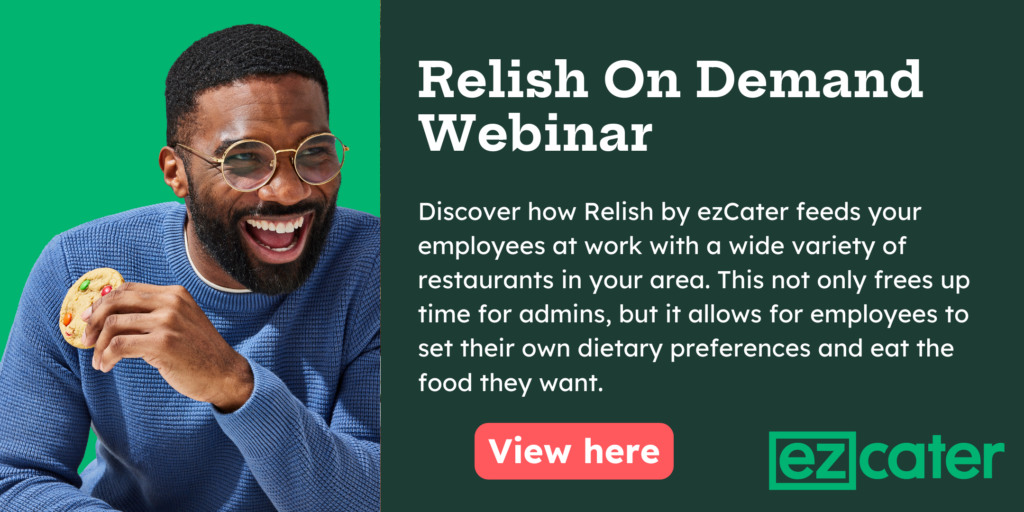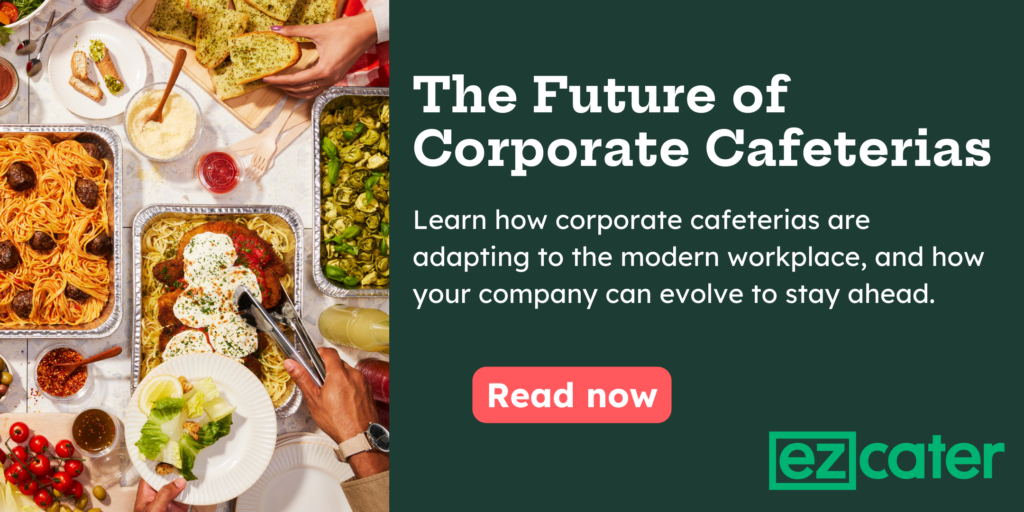Survey says: workplace cafeterias need a shake up
- Grace Trumpfeller
- •
- 3 Min Read
- •
Workplace cafeterias date back to the American Industrial Revolution, over a century ago. And while the Silicon Valley tech giants ushered in some changes in the 2010s (kombucha on tap, anyone?), today’s cafeterias are evolving quickly to adapt to the modern workplace. Offices and work schedules have pivoted to accommodate hybrid models, yet some traditional cafeterias still lag behind.
That is what ezCater’s new report, “Why Corporate Cafeterias Aren’t Working,” has confirmed.
In interviews with over 1200 employees and workplace leaders, we learned that these once-beloved spaces are losing popularity. Employees are less satisfied with their food options, and employers predict a huge overhaul of the cafeteria format. So, what’s next for corporate dining? Here’s a taste of what’s to come.
Why workplace cafeterias are overdue for change
Cafeterias may have been the status quo for corporate dining, but in today’s workplaces, change is on the menu. The balance between remote, hybrid, and fully on-site workforces continues to shift, and now, the golden age of workplace cafeterias is ready to be replaced — or complemented — by an era of flexibility.
Decision-makers agree: 66% of professionals involved in the day-to-day cafeteria operations are ready for a shake-up. The reasons why may seem familiar.
Cafeterias are expensive to set up and operate
The data doesn’t lie: decision makers surveyed by ezCater report that cafeterias can be expensive to establish and maintain. Nearly half say that their cafeterias exceed $1 million annually to operate. Not to mention, another 78% predict that cafeteria costs will rise in the coming year.
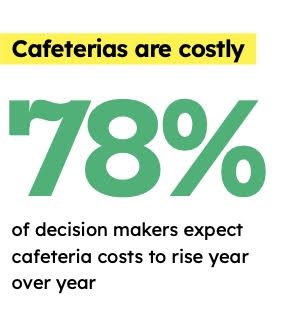
Fluctuating headcounts require flexibility
Ballooning budgets may be going to waste in hybrid workplaces. ezCater’s survey of cafeteria decision-makers found that more than a third of employees (36%) typically work on-site three days or less, and cafeterias are struggling to adapt their operations to headcounts that constantly fluctuate.
In a hybrid work environment, not knowing how much food you need to order and prepare on a daily basis can lead to wasted food — and money. The costs of and overhead of preparing food for a fully on-site workforce add up over time, so is it any wonder that 62% of decision-makers believe that flexible employee food solutions should replace the traditional cafeteria?
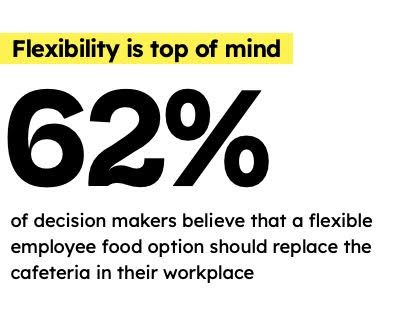
Food variety is lacking for today’s palates
Workers crave more from their workplace cafeterias, too. Not enough meal options is top of mind for employees: 76% admit wishing they had access to more variety of food options at work. Young Gen Z employees, especially, are showing cafeteria burnout — they’re 16% more likely than any other age group to prefer restaurant food over cafeteria food.
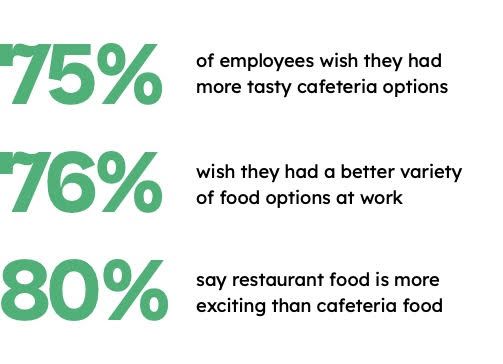
Special dietary needs aren’t addressed
For those with food allergies (about one in 10 adults) or employees following a special diet like veganism, food choices are even more limited. This is an issue decision-makers are paying attention to, with 41% acknowledging corporate cafeterias are not inclusive of dietary needs and preferences.
Employees are unhappy with the food quality
At the end of the day, the truth is in the tastebuds, and employees aren’t completely satisfied with the quality of the food they’re eating at work. 44% of workers surveyed rate what’s on their plates as very poor to average. One thing is clear: cafeteria menus are in need of a revamp.
Flexible food solutions for a variety of workplace needs
On-site cafeterias typically offer limited (and repetitive) food options. And even if they switch things up, it may not be as often as employees would like. Fortunately, there are reliable alternatives — like Relish by ezCater — that help companies adapt to fluctuating headcounts and achieve better food variety.
Greater cost savings
Between hiring staff, providing training, obtaining state licenses, and the cost of operating a commercial kitchen, running a corporate cafeteria can feel cost-prohibitive to some companies. Case in point? Growing Kansas City-based commercial real estate operating company, NorthPoint Development.
After moving into a new building, NorthPoint considered remodeling the existing cafeteria to continue feeding employees daily lunches. However, once they evaluated the costs of a complete cafeteria overhaul, the decided to rethink their plans and look for alternatives.
They found one. With Relish by ezCater, a flexible recurring employee meal program, NorthPoint Development reduced monthly lunch expenses by 35% — all while sourcing meals their 300+ employees actually feel excited about.
“When we moved into our new building, we looked into remodeling the existing cafeteria, but due to cost and overhead, it seemed more logical to continue on the path we were going. Finding Relish by ezCater saved us from having to renovate the space, hire staff, handle state licensing, and more… Everybody gets to choose their own meal. It’s their decision.”
Melissa Allinder, Office Operations Manager, NorthPoint Development
Better employee experience
Today’s employees are craving more than what’s available at traditional workplace cafeterias. In fact, seven in 10 want to swap their standard meal options for catered lunches from local restaurants. Granting them this one wish is good for everyone: workers eat the variety they crave, employee experience gets a boost, and companies enjoy the perks of greater engagement.
Free up valuable space
Workplace cafeterias don’t just take up a big chunk of company’s operation budgets; they take up a lot of room as well. Our latest report found that dining halls and kitchens occupy an average 9,900 square feet. That’s a lot of real estate dedicated to space that may not be used to its full potential.
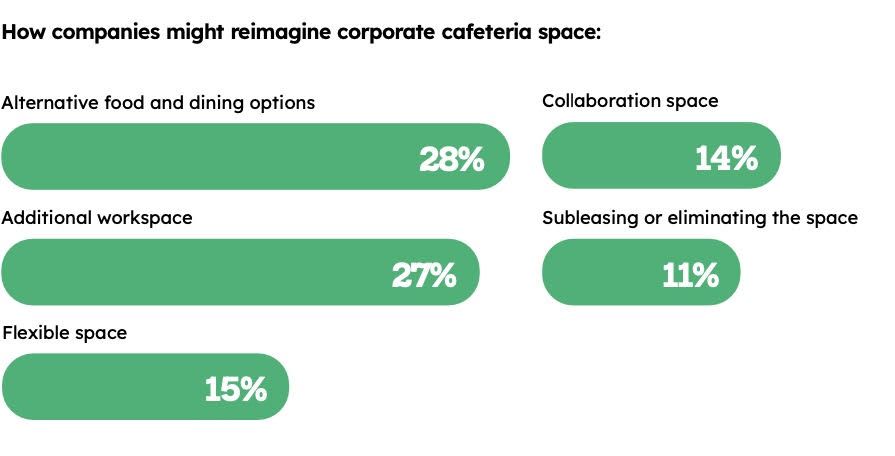
Imagine what nearly 10,000 additional square feet could offer your business. Extra workspace could allow employees to branch out from their desks, finding new inspiration in untapped spaces. A new collaboration space could encourage coworkers to spend more time working together rather than in silos, turbocharging company goals. Even if cafeterias don’t disappear completely, scaling them back gives you so many exciting possibilities to explore.
It’s time to reimagine workplace cafeterias
We’re approaching a new era of corporate cafeterias. As more businesses embrace flexibility, both in hybrid teams and alternative food solutions, it’s time to reimagine food at work.
Ready to future-proof your food-for-work solutions? Download the latest ezCater report, “Why Corporate Cafeterias Aren’t Working,” to learn what steps today’s workplace cafeteria leaders are taking.
